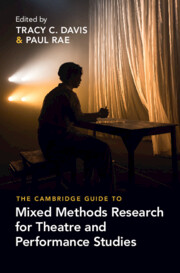Book contents
- The Cambridge Guide to Mixed Methods Research for Theatre and Performance Studies
- Reviews
- The Cambridge Guide to Mixed Methods Research for Theatre and Performance Studies
- Copyright page
- Contents
- Figures
- Tables
- Contributors
- Acknowledgements
- Introduction:
- Part I Planning
- Part II Doing
- Part III Interpreting
- Chapter 11 Methodologies Dialogue:
- Chapter 12 Non-linear Methodologies for Researching Early Modern Performance:
- Chapter 13 Taking Your Time:
- Chapter 14 Not Here for the Disciplines:
- Chapter 15 Methodologies Dialogue:
- Conclusion:
- Index
- References
Chapter 11 - Methodologies Dialogue:
Archives and Embodiments
from Part III - Interpreting
Published online by Cambridge University Press: 01 February 2024
- The Cambridge Guide to Mixed Methods Research for Theatre and Performance Studies
- Reviews
- The Cambridge Guide to Mixed Methods Research for Theatre and Performance Studies
- Copyright page
- Contents
- Figures
- Tables
- Contributors
- Acknowledgements
- Introduction:
- Part I Planning
- Part II Doing
- Part III Interpreting
- Chapter 11 Methodologies Dialogue:
- Chapter 12 Non-linear Methodologies for Researching Early Modern Performance:
- Chapter 13 Taking Your Time:
- Chapter 14 Not Here for the Disciplines:
- Chapter 15 Methodologies Dialogue:
- Conclusion:
- Index
- References
Summary
In this conversation, Adrian Curtin, Prarthana Purkayastha, and meLê yamomo highlight how their research on sound and dance engages embodied knowledges and vice versa. They account for how archival work challenges presumptions about the research process as well as what the scholar assumes they are looking for in the archive. The research process demands flexibility because studying performance invites interpretation, adaptation, and cultural understanding as intermediaries in understanding archival materials. Each participant emphasizes how, for them, research processes have incorporated creative endeavours because of the embodied and artistic dimensions of performance and historiographic analysis.
Information
- Type
- Chapter
- Information
- Publisher: Cambridge University PressPrint publication year: 2024
References
References
Accessibility standard: Unknown
Why this information is here
This section outlines the accessibility features of this content - including support for screen readers, full keyboard navigation and high-contrast display options. This may not be relevant for you.Accessibility Information
- 1
- Cited by
